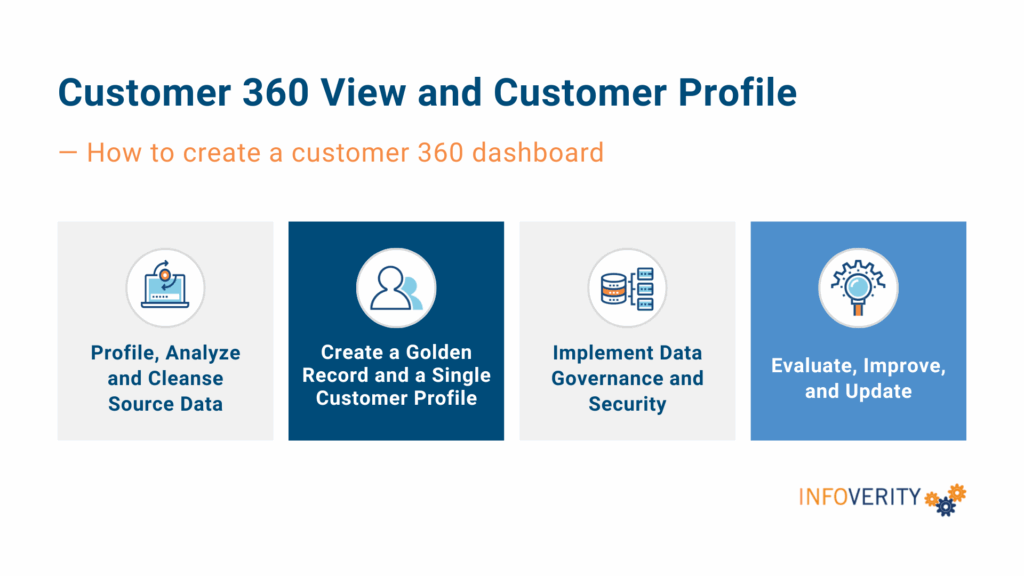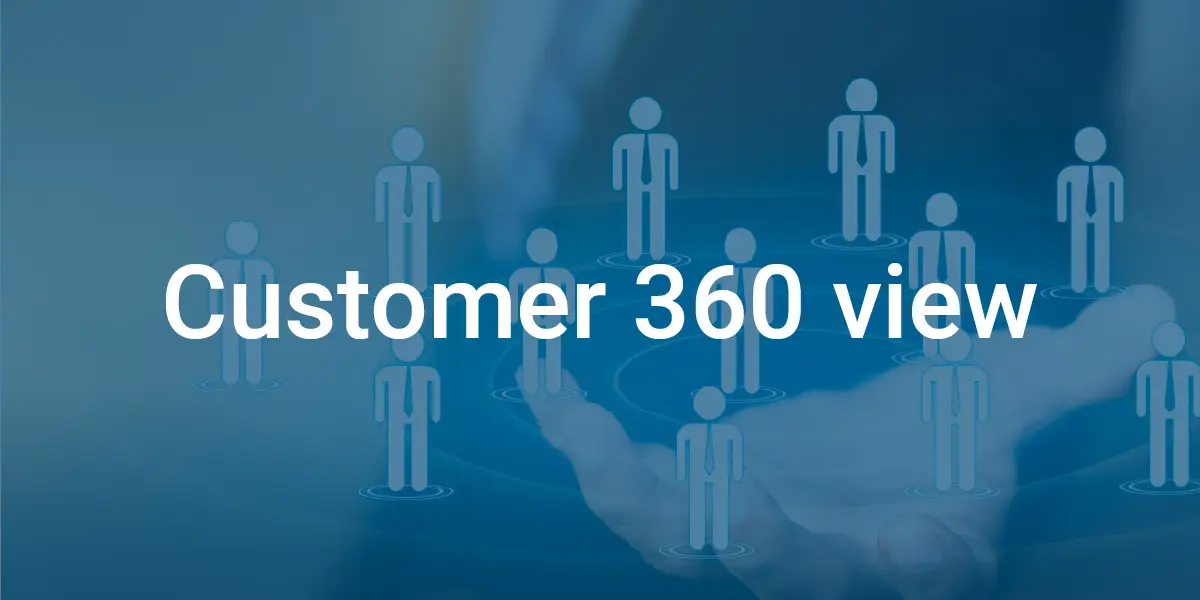A customer 360 view creates a single source of truth by stitching together disparate sources of customer data providing a holistic view across channels, interactions, relationships, and purchases. This view allows marketers to build tailor-made campaigns and operations to provide personalized customer service experiences.
However, according to Gartner’s marketing survey, only 14% of organizations have achieved a 360-degree customer view.
This article will shed light on how to create a comprehensive customer 360 view by integrating data from various sources.
Table of Contents: Customer 360 View
Customer 360 View Definition
Customer 360 is a trusted and integrated dataset that offers a unified, 360-degree view of the customer to help build the customer journey.
This single source of truth is created by generating a single master record for each customer. This record, often dubbed the golden record, is based on data from both internal and external sources.
This complete view empowers businesses to:
- Anticipate customer needs,
- Tailor their offerings, and
- Create personalized customer experiences.
Customer 360 Data Sources
A customer 360 view provides a data profile that goes beyond name and address. This is obtained by combining sources of data, such as:
Internal Data Sources
Key internal systems, such as Enterprise Resource Planning (ERP) and Customer relationship management (CRM) typically provide the core customer information. But other data sources help round out the profile.
CRM software, for example, includes customer data such as:
- Clients’ contact information,
- Emails,
- Phone conversations,
- Purchase history, and
- Preferences.
Social Media
Opinions, feedback, and preferences shared by customers on social media channels give organizations a clearer vision of their needs and how customers engage with the brand.
For instance, a software provider participating in customer conversations on Facebook or Twitter might identify potential new product features.
Third-Party Data
Data from external sources not only enhance internal data but also can provide a cleansed version of key information.
Research
Hubspot 2024 State of Consumer Trends shows that 58% of people interviewed have used Facebook for in-app purchases and 51% Tik-Tok. Businesses can tap into this general information about preferences and market trends to fine-tune their marketing strategies.
Customer 360 View Benefits
A 360 view of the customer enables organizations to offer outstanding experiences and boost customer satisfaction and brand loyalty. Adopting a master data management (MDM) solution to handle customer data from multiple sources allows firms to:
1. Boost Marketing Campaigns
MDM takes the customer 360 view to the next level by providing superior data quality and multi-domain functionalities. Businesses can achieve higher engagement and conversion rates by leveraging this expanded view to:
- Create targeted marketing campaigns . A recent study confirms that 70% of companies using advanced personalization earn at least a 200% return on investment (ROI). Furthermore, Arion Research demonstrated that 82% of customers remain loyal to businesses using their preferred communication channels. A customer 360 view lets organizations target the right clients with suitable offers and messages. For example, if a financial institution knows that a customer bought a new car, the bank can send him personalized car insurance offers.
- Build a customer journey . Successful marketing campaigns are built on fresh data. For example, if a mobile provider customer journey shows a need to compare plans, the provider can craft a message displaying the alternatives available.
- Identifying cross-sell/upsell opportunities for existing customers. According to Hubspot, cross-selling and upselling drive on average 21% of a business’s revenue. Analyzing customer data can help firms pinpoint the right product recommendations. For instance, if a customer buys a set of laptops, the retailer might recommend suitable backpacks or carrying cases.
- Determine the next best action (NBA) of products for customers. Leveraging data from customer interactions, enterprises can identify and address unmet customer needs (i.e., white space).
- Establish marketing efforts driving increased purchasing behavior. A 360-degree customer view provides organizations with a deeper understanding of the factors that influence customers’ purchasing decisions and motivations. Today 71% of B2B buyers are Millennials and Generation Zers who have different behaviors and priorities. Research shows that 87% of Gen Z consumers would buy from brands that work with influencers. Organizations might want to focus their marketing campaigns on a trendy influencer to further connect with younger audiences.
2. Enhance Customer Experience
74% of B2B buyers would switch to another B2B supplier if it would offer a better experience. Consolidating information to build a customer 360 view rewards enterprises with precise insights across all channels and touchpoints enabling them to:
- Deliver a cohesive omni-channel customer experience. A report from 360DigitalCommerce shows that B2B buyers use from three to ten digitally driven channels. An accurate view ensures that no matter which channels the customer uses, the customer experience remains consistent.
- Nurture relationships to reduce churn. Companies can leverage the holistic customer view to identify clients at risk of churning and offer them a personalized deal.
3. Elevate Business Intelligence Reporting
Customer 360 view is essential to accurate business intelligence (BI) reporting as it:
- Stitches transactional data with the golden record. Adding updated customer information to product purchases helps businesses identify buying patterns. Thus, retailers can predict the demand for specific products at any given time and target them with relevant coupons or discounts.
- Adds corporate linkage data to roll up revenue, products, and orders. Corporate linkages enable organizations to understand total customer spend and identify white space.
- Helps Identify the most profitable customers. BI reporting based on an accurate view facilitates the identification of a company’s most profitable customers. It also contributes to detecting which accounts are more likely to expand and which might be at risk of churn. Marketing analysts can then shift focus to those customers and optimize campaigns and tactics accordingly.
Looking for building a complete customer 360 view?
Start your data-driven journey. Infoverity can help you build a great 360-degree view of your customers and reach your revenue goals.
Designing a Customer 360 View and Customer Profile
A customer 360 dashboard provides a holistic view of a customer. To create it, organizations must follow a four step process:

1. Profile, Analyze and Cleanse Source Data
Once the data sources have been identified, from both internal and external systems, the data should be cleansed to ensure accuracy and completeness.
When done, the data can be ingested into a Master Data Management system.
2. Create a Golden Record and a Single Customer Profile
A master customer record (i.e., golden record) is generated to minimize inconsistencies. The record will then be used to build a comprehensive customer profile embedding all crucial information, such as:
- Revenue.
- Products purchased.
- Lifetime value.
- Customer service interactions.
- Channel interactions.
- Marketing behavior.
- Demographic data.
- Relationships.
3. Implement Data Governance and Security
In 2024, data privacy regulations like the European Union General Data Protection Regulation (EU GDPR) and the California Consumer Privacy Act (CCPA) are raising the stakes for all businesses. Compliance with these regulations requires rigorous data management practices.
Setting up data governance processes and policies will ensure data accuracy, security, and privacy. It will help organizations understand the best way to manage data in compliance with government and industry privacy regulations.
Both Consumers and Businesses value data security and privacy. According to Hubspot, 72% of surveyed consumers say they prefer to buy from businesses protecting their sensitive data.
4. Evaluate, Improve, and Update
Keep data up to date to capture changes to the customer view. Regular assessments will also facilitate the identification of areas for improvement and ensure data accuracy and completeness.
Building a Complete Customer 360 View for Business Growth
A customer 360 view begins with the creation of a master record and the consolidation of all internal and external data collected. It provides a holistic view of a customer which can be used across the organization to improve sales, marketing, and the customer experience.
Start your data-driven journey. Contact Infoverity today to learn how we can help you build a great 360-degree view of your customers and reach your revenue goals.
FAQ – Customer 360 view
What is a customer 360 view?
Customer 360 is a trusted and integrated dataset that offers a unified, 360-degree view of the customer to help build the customer journey. This single source of truth is created by generating a single master record for each customer. This record, often dubbed the golden record, is based on data from both internal and external sources.
What are the benefits for customer 360 view?
A 360 view of the customer enables organizations to offer outstanding customer experiences and boost customer satisfaction and brand loyalty. Adopting a master data management (MDM) solution to handle customer data from multiple sources allows firms to boost marketing campaigns, enhance customer experience and elevate business intelligence reporting.
How to design a customer profile dashboard?
A Customer 360 Dashboard provides a holistic view of a customer. To create it, organizations must follow a four step process: profile, analyze and cleanse source data; create a golden record and a single customer profile; implement data governance and security; and evaluate, improve, and update.
What are the sources for customer 360 data?
A customer 360 view provides a profile of the customer that goes beyond name and address. This begins with the creation of a master record and the consolidation of all internal and external data collected. This data is obtained by combining sources of data, such as internal data sources, social media or third-party data.



